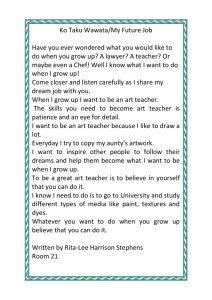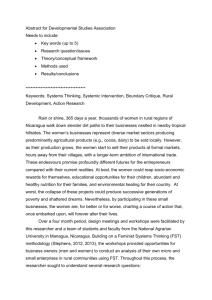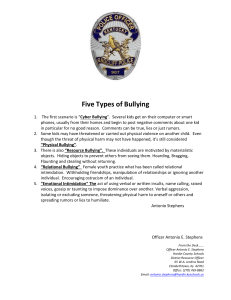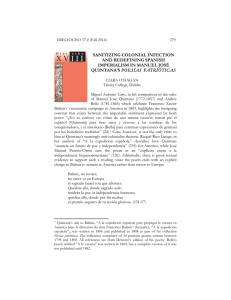Sample Essay 3 Images Versus Words
advertisement
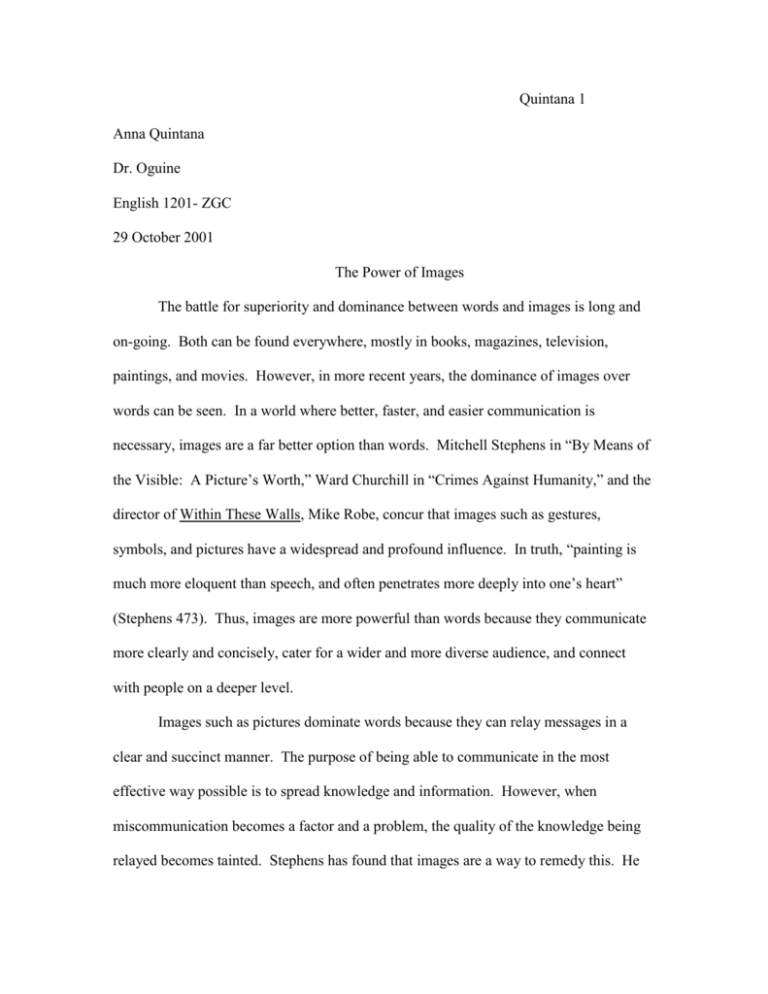
Quintana 1 Anna Quintana Dr. Oguine English 1201- ZGC 29 October 2001 The Power of Images The battle for superiority and dominance between words and images is long and on-going. Both can be found everywhere, mostly in books, magazines, television, paintings, and movies. However, in more recent years, the dominance of images over words can be seen. In a world where better, faster, and easier communication is necessary, images are a far better option than words. Mitchell Stephens in “By Means of the Visible: A Picture’s Worth,” Ward Churchill in “Crimes Against Humanity,” and the director of Within These Walls, Mike Robe, concur that images such as gestures, symbols, and pictures have a widespread and profound influence. In truth, “painting is much more eloquent than speech, and often penetrates more deeply into one’s heart” (Stephens 473). Thus, images are more powerful than words because they communicate more clearly and concisely, cater for a wider and more diverse audience, and connect with people on a deeper level. Images such as pictures dominate words because they can relay messages in a clear and succinct manner. The purpose of being able to communicate in the most effective way possible is to spread knowledge and information. However, when miscommunication becomes a factor and a problem, the quality of the knowledge being relayed becomes tainted. Stephens has found that images are a way to remedy this. He Quintana 2 reasons that because “primates are visual animals, and think best in pictorial or geometric terms,” humans need images in order to fully explain and/or understand a concept (480). Unfortunately, the Nazis understood the power of this theory. Churchill found that while spreading anti-Semitic propaganda, the Nazis drew “grotesque caricatures of Jewish faces” (498). Immediately, messages of inferiority and hatred spread throughout Germany. Even without words, such pictures had a profound effect. It influenced “average Germans to later indulge in the outright liquidation of Jewish ‘vermin’” (501). Even though images were used negatively, it is clear that they have a deep effect on people’s perception and understanding. Words, however, cannot have the same effect. Because abstract words and emotions such as hate require “a deep understanding,” they “can be put into images but are difficult to put into words” (Stephens 480). Therefore, images remain dominant over words because a single picture can depict complex emotions that no word or group of words can accomplish. The universal appeal of images, such as symbols, also assists in its ability to garner a wide and diverse audience. Images can speak and move people, regardless of their intellectual level or cultural background. In fact, people often “take advantage of the accessibility of images to aid those who may not understand a particular language” (Stephens 479). Oftentimes, a foreigner’s ability to communicate to others is hindered by his or her reliance on foreign language and words. However, when the same person sees a skull-and-crossbones symbol, he or she can understand this to mean danger. The ability for images such as this to “take the place of words” is a great advantage, especially in today’s multi-racial, multi-lingual world (476). The universality of images is also Quintana 3 acknowledged in America. However, like in Germany, symbols are used to spread insulting and stereotypical ideas about a particular culture. In effect, “a substantial number of American Indians have protested the use of native names, images, and symbols as sports team mascots and the like” (Churchill 497). These protestors claim that such degrading images teach young children “a virulently racist practice” (497). They insist that dehumanizing messages can be understood by everyone- whether a person is a young, African-American child or an old Caucasian. Thus, whether images are used positively or negatively, its ability to reach and impact a variety of people is still far greater than words. Furthermore, people connect with images on a deeper, more personal level than words. Images can “excite the emotions, which are more effectively aroused by things seen than by things heard” (Stephens 479). The women’s facial expressions and gestures in the movie Within These Walls prove this. For example, the sight of the nun’s discolored and greatly scarred arm proves to the audience that her life is harder than it was previously depicted. Such an image brings about deeper, more complex levels of emotion such as pain, sadness and misfortune without requiring any explanation in words. Also, images such as gestures are necessary in order for people to successfully interact with one another. Listening to one another or reading written text is not sufficient for a person to fully understand a particular message. To be more specific, words and “letters don’t smile warmly or look intently” (Stephens 481). Because of this, people naturally tend to observe each other while interacting, usually “by observing people’s faces as they speak” (481). In fact, non-verbal communication, such as a frown, Quintana 4 grimace, or smile, is greatly used in the movie between the inmates and guards. Officer Byrd’s stern, rigid face and posture symbolize power and authority. Likewise, Joan’s wrinkled, darkened, and defeated expression evokes powerlessness and fatigue. Because of the obscurity of words, images are an essential component for explaining complicated thoughts upon audiences. Finally, images, whether they are pictures, symbols or gestures, are more advantageous than words. Stevens, Churchill, and the director of Within These Walls, Mike Robe, all agree that images’ independence from written text shows their versatility and power in sending thoughts and insights to people. The lack of abstractness and obscurity is their greatest strength because they allow people to connect their thoughts with specific and concrete ideas and feelings. Their influence on society’s way of communicating is great and long-lasting. Images will forever be superior to words in their ability to spread ideas to a diverse and complicated world. Quintana 5 Works Cited Churchill, Ward. “Crimes against Humanity.” The Presence of Others. 3rd ed. Ed. Andrea A. Lunsford and John J. Ruszkiewicz. New York: Bedford, 2000. 497504. Stephens, Mitchell. “By Means of the Visible: A Picture’s Worth.” The Presence of Others. 3rd ed. Ed. Andrea A. Lunsford and John J. Ruskiewicz. New York: Bedford, 2000. 473-487. Within These Walls. Dir. Mike Robe. Perf. Latanya Richardson, Maria Herrera, Lucinda Davis, Karen Glave, Lynne Adams. Lifetime Original Movie, 2001.
